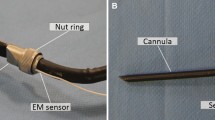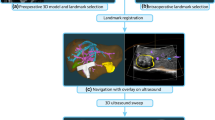Abstract
Purpose
This study was designed to evaluate the accuracy and safety of electromagnetic needle tracking for sonographically guided percutaneous liver biopsies.
Methods
We performed 23 consecutive ultrasound-guided liver biopsies for liver nodules with an electromagnetic tracking of the needle. A sensor placed at the tip of a sterile stylet (18G) inserted in a coaxial guiding trocar (16G) used for biopsy was localized in real time relative to the ultrasound imaging plane, thanks to an electromagnetic transmitter and two sensors on the ultrasound probe. This allows for electronic display of the needle tip location and the future needle path overlaid on the real-time ultrasound image. Distance between needle tip position and its electronic display, number of needle punctures, number of needle pull backs for redirection, technical success (needle positioned in the target), diagnostic success (correct histopathology result), procedure time, and complication were evaluated according to lesion sizes, depth and location, operator experience, and “in-plane” or “out-of-plane” needle approach.
Results
Electronic display was always within 2 mm from the real position of the needle tip. The technical success rate was 100%. A single needle puncture without repuncture was used in all patients. Pull backs were necessary in six patients (26%) to obtain correct needle placement. The overall diagnostic success rate was 91%. The overall true-positive, true-negative, false-negative, and failure rates of the biopsy were 100% (19/19) 100% (2/2), 0% (0/23), and 9% (2/23). The median total procedure time from the skin puncture to the needle in the target was 30 sec (from 5–60 s). Lesion depth and localizations, operator experience, in-plane or out-of-plane approach did not affect significantly the technical, diagnostic success, or procedure time. Even when the tumor size decreased, the procedure time did not increase.
Conclusions
Electromagnetic-tracked biopsy is accurate to determine needle tip position and allows fast and accurate needle placement in targeted liver nodules.







Similar content being viewed by others
References
Bret PM, Fond A, Casola G et al (1986) Abdominal lesions: a prospective study of clinical efficacy of percutaneous fine-needle biopsy. Radiology 159:345–346
Hopper KD (1995) Percutaneous radiographically guided biopsy: a history. Radiology 196:329–333
Dodd GD III, Esola CC, Memem DS et al (1996) Sonography: the undiscovered jewel of interventional radiology. Radiographics 16:1271–1288
Horigome H, Nomura T, Saso K et al (1999) Limitations of imaging diagnosis for small hepatocellular carcinoma: comparison with histological findings. J Gastroenterol Hepatol 14:559–565
Ikai I, Arii S, Kojiro M et al (2004) Reevaluation of prognostic factors for survival after liver resection in patients with hepatocellular carcinoma in a Japanese nationwide survey. Cancer 101:796–802
Bolondi L, Gaiani S, Celli N et al (2005) Characterization of small nodules in cirrhosis by assessment of vascularity: the problem of hypovascular hepatocellular carcinoma. Hepatology 42:27–34
Kojiro M (2004) Focus on dysplastic nodules and early hepatocellular carcinoma: an Eastern point of view. Liver Transpl 10:3–8
Gupta S (2004) New techniques in image-guided percutaneous biopsy. Cardiovasc Intervent Radiol 27(2):91–104
Cardella J, Bakal C, Bertino R, for the Society of Interventional Radiology et al (2003) Standards of Practice Committee Quality Improvement Guidelines for image-guided percutaneous biopsy in adults. J Vasc Interv Radiol 14:227–230
Sheafor DH, Paulson EK, Simmons CM et al (1998) Abdominal percutaneous interventional procedures: comparison of CT and US guidance. Radiology 207(3):939–942
Kliewer MA, Sheafor DH, Paulson EK et al (1999) Percutaneous liver biopsy: a cost-benefit analysis comparing sonographic and CT guidance. Am J Roentgenol 173:1199–1202
Howard MH, Nelson RC, Paulson EK et al (2001) An electronic device for needle placement during sonographically guided percutaneous intervention. Radiology 218(3):905–911
Krücker J, Xu S, Glossop N et al (2007) Electromagnetic tracking for thermal ablation and biopsy guidance: clinical evaluation of spatial accuracy. J Vasc Interv Radiol 18(9):1141–1150
Bergin D, Pappas JN, Hwang JJ et al (2002) Echogenic polymer coating. Does it improve needle visualization in sonographically guided biopsy? Am J Roentgenol 178:1188–1190
Charbonneau JW, Reading CC, Welch TJ (1990) CT and sonographically guided needle biopsy: current techniques and new innovations. Am J Roentgenol 154:1–10
Braak SJ, Van Strijen MJL, Van Leersum M et al (2010) Real-time 3D fluoroscopy guidance during needle interventions: technique, accuracy, and feasibility. Am J Roentgenol 194(5):445–451
Caturelli E, Solmi L, Anti M et al (2004) Ultrasound guided fine needle biopsy of early hepatocellular carcinoma complicating liver cirrhosis: a multicentre study. Gut 53:1356–1362
Memel DS, Dodd GD, Esola CC (1996) Efficacy of sonography as a guidance technique for biopsy of abdominal, pelvic, and retroperitoneal lymph nodes. Am J Roentgenol 167(4):957–962
Stattaus J, Kuehl H, Ladd S et al (2007) CT-guided biopsy of small liver lesions: visibility, artifacts, and corresponding diagnostic accuracy. Cardiovasc Intervent Radiol 30:928–935
Sheafor DH, Paulson EK, Kliewer MA et al (2000) Comparison of sonographic and CT guidance techniques: does CT fluoroscopy decrease procedure time? Am J Roentgenol 174(4):939–942
Conflict of interest
The authors declare that they have no conflict of interest.
Author information
Authors and Affiliations
Corresponding author
Rights and permissions
About this article
Cite this article
Hakime, A., Deschamps, F., De Carvalho, E.G.M. et al. Electromagnetic-Tracked Biopsy under Ultrasound Guidance: Preliminary Results. Cardiovasc Intervent Radiol 35, 898–905 (2012). https://doi.org/10.1007/s00270-011-0278-8
Received:
Accepted:
Published:
Issue Date:
DOI: https://doi.org/10.1007/s00270-011-0278-8




